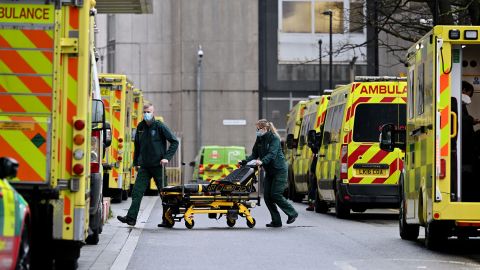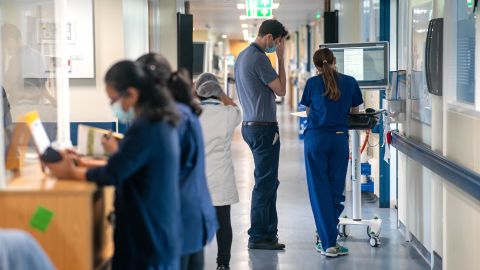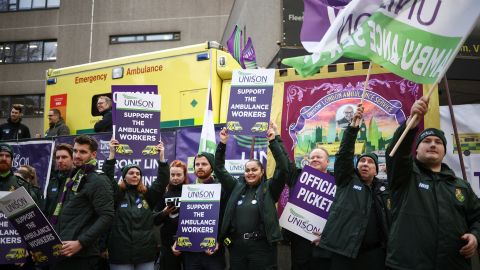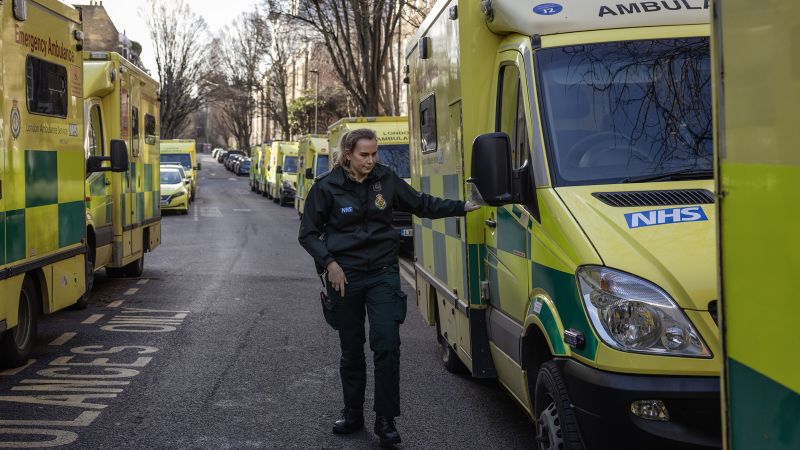London
CNN
—
Most winters, headlines warn that Britain’s National Health Service (NHS) is at “breaking point.” The alarms sound over and over and over again. But the current crisis has set warning bells ringing louder than before.
“This time feels different,” said Peter Neville, a doctor who has worked in the NHS since 1989. “It’s never been as bad as this.”
Scenes that would until recently have been unthinkable have now become commonplace. Hospitals are running well over capacity. Many patients don’t get treated in wards, but in the back of ambulances or in corridors, waiting rooms and cupboards – or not at all. “It’s like a war zone,” an NHS worker at a hospital in Liverpool told CNN.

These stories are borne out by the data. In December, 54,000 people in England had to wait more than 12 hours for an emergency admission. The figure was virtually zero before the pandemic, according to data from NHS England. The average wait time for an ambulance to attend a “category 2” condition – like a stroke or heart attack – exceeded 90 minutes. The target is 18 minutes. There were 1,474 (20%) more excess deaths in the week ending December 30 than the 5-year average.
Ambulance staff and nurses have staged a series of strikes over pay and working conditions, with the latest walkout by ambulance workers happening Monday. More are planned for the coming weeks. The chief executive of the NHS Confederation, which represents NHS organizations in England, wrote to the government on the eve of an ambulance strike last month to warn of NHS leaders’ concerns that they “cannot guarantee patient safety” that day. In response, a government health minister advised the public to avoid “risky activity.”
While the NHS has suffered crises before, this winter has brought a new reality: In Britain, people can no longer rely on getting healthcare in an emergency.
Founded shortly after World War II, the NHS is treated with an almost religious reverence by many. Britons danced for it during the 2012 London Olympics and clapped for it during the pandemic. “Our NHS” is a source of national pride.
Now, it is coming unstuck. There has long been an implicit contract between British people and the state: Pay taxes and National Insurance contributions in return for a health service that is free at the point of use.
But, with the tax burden on track to reach its highest sustained level since the NHS was founded, Britons are paying more and more for a service they increasingly cannot access as quickly as they need.
Some of these strains can be seen elsewhere in Europe. Doctors in both France and Spain have held strikes in recent weeks, as many countries face the same problems of providing care to an increasingly aging population – when inflation is at its highest level in decades.
Yet there are fears that the NHS is in worse shape than its international peers, and CNN spoke with experts who said they fear they’re witnessing the “collapse” of the service.
So how did Britain get here?
When Covid-19 hit, the NHS went into full crisis-fighting mode, diverting staff and resources from across the organization to care for patients with the disease.
But, for many in the NHS, Covid-19 remains a crisis from which they are yet to emerge.
During the height of the pandemic, many ordinary practices were put on hold. Millions of operations were canceled. The NHS “backlog” has ballooned. Data from November showed there were more than 7 million people on a hospital waiting list in England.
This winter, a “twindemic” of Covid and flu continues to put additional strain on capacity.

Explanations for the current crisis “have to start with a consideration of Covid-19,” Ben Zaranko, an economist at the Institute for Fiscal Studies (IFS) whose work focuses on Britain’s health care system, told CNN. “There’s the simple fact that there are beds in hospitals occupied by Covid patients, which means those beds can’t be used for other things.”
Covid also created a strain on the amount of work the NHS can do. “If you add up all the time that staff spend doing infection control measures, donning protective equipment and separating out wards into people with and without Covid … that might impede the overall productivity of the system,” Zaranko said. Rates of NHS staff sickness are also considerably higher than they were pre-pandemic, according to IFS analysis.
But, again, Britain was not alone in battling the pandemic, yet it appears to have suffered a worse hit than comparable nations.
This is despite there being more doctors and nurses in the NHS now than there were before Covid. According to an IFS report, even after adjusting for staff sickness absences, there are 9% more consultants, 15% more junior doctors and 8% more nurses than in 2019.
Yet the NHS is treating fewer patients than before the pandemic.
“It seems to be that bits of the system aren’t fitting together anymore,” Zaranko said. “It’s not just about how much staff there are and how much money there is. It’s how it’s being used.”
Even with the increase in funding since the pandemic, the UK is still playing catchup, after what critics say is more than a decade of underfunding the NHS.
Neville, a consultant in a hospital, judges 2008 the “best” he has seen the NHS in more than 30 years of working in it. By that time, the NHS had enjoyed nearly a decade of hugely increased investment. Waiting lists fell substantially. Some even complained about getting doctor appointments too quickly.
“When the Labour government came in in 1997, they injected considerably more money into the NHS. It enabled us to appoint an adequate number of staff and get on top of our waiting lists,” Neville told CNN.
But this level of investment did not last. In response to the 2007-2008 financial crisis, the Conservatives elected in the coalition government in 2010 embarked on a program of austerity. Budgets were cut and staff salaries frozen. For Neville, the ensuing decade saw a gradual “erosion” of the system: “Slow, subtle, but nonetheless happening.”

According to analysis by health charity the Health Foundation, average day-to-day health spending in the UK between 2010 and 2019 was £3,005 ($3,715) per person per year – 18% below the EU14 [countries that joined the EU before 2004] average of £3,655 ($4,518).
During this period, capital expenditure – the amount spent on buildings and equipment – was especially low, according to the Health Foundation analysis. The UK has far fewer MRI and CT scanners per person than the Organisation for Economic Co-operation and Development (OECD) average, meaning staff often have to wait for equipment to become available.
Hospital beds are particularly scarce. Over the past 30 years the number of beds in England has more than halved, from around 299,000 in 1987 to 141,000 in 2019, according to analysis by the King’s Fund, an independent think tank.
Siva Anandiciva, chief analyst at the King’s Fund, told CNN this decrease was partly attributable to the “changing model of care.” As technology and treatments improved, people spent less time in hospital, reducing the need for beds. The last Labour government, in power from 1997 to 2010, also cut bed numbers, despite increasing investment elsewhere.
“You can keep reducing how long patients stay in hospital,” said Anandaciva, but eventually “you approach a minimum. If you then keep cutting bed numbers … that’s when you start to get into problems like performance.”
During the austerity years, bed numbers continued to be cut, leaving the UK with fewer beds per capita than almost any developed nation, according to OECD data.
“For a long time we knew we just didn’t have the bed capacity,” Anandaciva said. But cuts continued in the name of “efficiency,” he added.
While low bed numbers were seen as a marker of “success” indicating that the NHS was running efficiently, it left the UK woefully underprepared for a shock like Covid-19. The same factors that made the NHS “efficient” in one context made it grossly inefficient when that context changed, in his analysis.
The bed shortage has been made even more acute by the fact that many of those in hospital no longer need to be there – there is simply nowhere else for them to go.
“The longest I had a patient that was physically and medically ready to go home, but was sitting around waiting for discharge, was four weeks,” said Angus Livingstone, a doctor working in the John Radcliffe Hospital in Oxford.
The problem is caused by a crisis in another sector: Social care. Patients that could leave the hospital end up staying there because they cannot access more modest care in a home setting and so cannot be safely discharged.

Health and social care are separate sectors in the UK system. Healthcare is provided by the NHS, whereas social care is provided by local councils. Unlike the NHS, social care is not free at the point of use: It is rationed and means-tested.
There have long been calls to integrate the two systems, since a crisis in one system feeds through into the other.
“If you allow us to regain the enormous number of beds that are currently occupied by people awaiting social care, then I would be very confident that the immediate snarl-up in A&E and ambulances waiting outside would pretty much disappear overnight,” Neville said.
“When people ask me, ‘where do you want the money in the NHS?’ My answer is ‘I don’t want it in the NHS. I want it in social care.’”
With an increasingly aging population – the latest census data show nearly 19% of the population of England and Wales is now 65 or older – demand for social care is increasing. But the sector is struggling to provide it in the face of staffing shortages, rising costs and funding pressures.
Care work can be grueling and underpaid. Most supermarkets offer a better hourly wage, analysis from the King’s Fund found. So, it is perhaps unsurprising that the sector reported 165,000 vacancies in August.
The NHS is also reporting an alarming number of vacancies, with about 133,000 open positions as of September.
This points to a deeper crisis: Morale.
Jatinder Hayre, a doctor completing the foundation program at a hospital in East London, told CNN that morale is “at an all time low.” Staff are “stressed, fatigued, tired,” he said. “There doesn’t seem to be an end to this.”
“When you walk into the hospital in the morning, you’re met with this cacophony of grief and dismay and dissatisfaction from patients, who are lined up in the corridor,” Hayre said.
“You feel awful, but there’s nothing you can do. You’re fighting against a system that’s collapsing.”
Hayre said that most days there are “around 40 to 50 patients lined up in the corridors” as there is no space left in the wards. “It’s not appropriate. It’s not a safe or dignified environment.”
Unable to deliver an acceptable standard of care, many staff are demoralized – and considering their options. At Hayre’s hospital, “the day-to-day workplace talk is, ‘are we going to leave?’”

A junior doctor at a hospital in Manchester, who wished to remain anonymous, told CNN that she had made the decision to join the growing number of NHS doctors who are moving abroad. She plans to move abroad in the summer, to work in a country that offers doctors better pay and working conditions.
Of the eight doctors she lived with at university, six have already left. “They’ve all gone to Australia. They love it,” she said. Only one is planning to stay in the UK.
Medical students are watching in alarm as their future workplace deteriorates.
“For everyone I know, it’s almost a given that at some point they’re going to go to Australia or New Zealand,” said Eilidh Garrett, who studies medicine at Newcastle University. She is considering taking exams to work as a doctor in Canada.
This is a hugely painful decision for many young doctors. “I think about my closest friends. If I go to another country and treat other people’s closest friends, while my friends struggle to see a doctor in the UK – that is really heartbreaking,” Garrett told CNN.

Meanwhile, Britain’s vote to leave the European Union in 2016 has likely not helped the situation. Research by the Nuffield Trust health think tank, published in November, finds that long-standing staff shortages in nursing and social care “have been exacerbated by Brexit.”
The picture is “more complex” for doctors working in the NHS, the researchers found. While overall “EU numbers have remained relatively stable,” the report says, the data suggest a slowdown in the registration of specialists from the EU and European Free Trade Association countries since Brexit, particularly in certain specialties such as anesthetics.
The concern is that these issues get worse the longer they go untreated.
When patients finally get seen, their treatments take more time, forcing those after them to wait even longer as they get sicker.
“In terms of the system performance, it feels like we’re past the tipping point,” Zaranko said. “The NHS has been gradually deteriorating in its performance for some time. But we’ve gone off a cliff in recent months.”
It is unclear how the NHS regains its footing. Some compare this crisis to a period in the 1990s when services were rapidly deteriorating. The NHS was in bad shape, but restored its levels of service after a decade of historically high investment while Labour was in power.
Injections of cash on this scale are unlikely to be replicated. The most recent budget announced by the government in November will see NHS England spending rise by only 2% in real terms on average over the next two years.

“We recognize the pressures the NHS is facing so announced up to £250 million [$309 million] of additional funding to immediately help reduce hospital bed occupancy, alleviate pressures on A&E and unlock much-needed ambulance handovers,” a spokesperson from the Department of Health and Social Care told CNN in a statement.
“This is on top of the £500 million [$618 million] Discharge Fund to speed up the safe discharge of patients and rolling out virtual wards to free up hospital beds and cut waiting cuts,” the statement continued.
Pay negotiations between the government and nursing unions have so far been unsuccessful. British media outlets have reported that Prime Minister Rishi Sunak may be considering offering a one-off hardship payment of £1,000 ($1,236) to attempt to resolve the dispute, but many feel this underestimates the true nature of the crisis.
“All I hear about is sticking plasters,” Neville said. “It depresses us all.”

